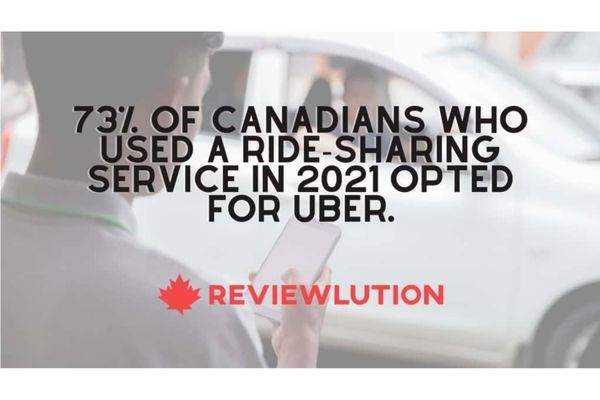15 Astounding Sharing Economy Statistics
The sharing economy is now a buzzword in the business world. Airbnb, Uber, and Spotify are among the biggest sharing economy apps that everyone is familiar with.
That being said:
There are numerous other sites and apps that operate on the same principle – acquiring and sharing access to products and services.
To learn more about this growing trend in Canada and abroad, we decided to delve deep into the latest sharing economy statistics.
Here’s a preview of what we found:
Exciting Sharing Economy Statistics (Editor’s Choice)
- The global sharing economy revenue will rise from US$18.6 billion in 2017 to an estimated US$40.2 billion in 2022.
- The Canadian sharing economy is worth $1.3 billion.
- 2.7 million Canadians aged 18 and older participate in the sharing economy.
- Less than 1% of Canadians made money through the sharing economy.
- About 73% of Canadians favour Uber when it comes to ride-sharing services.
- Uber contributed an estimated $6.5 billion to the Canadian economy in 2020.
- Between 2016 and 2017, Calgary generated a 146% increase in Airbnb revenue.
- Around 9% of surveyed Canadians have worked in the sharing economy.
Sharing Economy Statistics for Canada
1. The Canadian sharing economy is worth $1.3 billion.
(Source: Canada West Foundation)
The number of active Airbnbs in Canada nearly doubled between 2015 and 2016. Private rentals increased from 52,000 to 100,500, while hotel occupancy increased at a compound annual growth rate (CAGR) of just under 1%. Airbnb and Flipkey Canada are the leading accommodation choices for Canadians.
2. Around 2.7 million Canadians aged 18 and older participated in the sharing economy in 2015-2016.
(Source: 150 Stat Can)
The latest government statistics on the sharing economy are from 2017. That year, a survey found that between November 2015 to October 2016, about 2.7 million adult Canadians took part in the sharing economy through the use of peer-to-peer ride services or private accommodation services – an equivalent of 9.5% of the population.
This contributed to overall spending on peer-to-peer ride services of $241 million. Meanwhile, private accommodation services surpassed the $1 billion mark.
3. According to sharing economy statistics, around 9% of surveyed Canadians have worked in the sector.
(Source: CBC)
In an online survey conducted by Environics Research in 2017, around 9% of 2,304 respondents said they work or had worked in the sharing economy. Their jobs span various services, from rides and repairs to food delivery and rental accommodations.
Now:
Among the respondents who had worked in the sharing economy, about 71% were younger than 45. So, sharing economy workers are relatively young. The same survey also found that 51% of the workers had children under the age of 18.
4. Less than 1% of Canadians make money through the sharing economy.
(Source: Financial Post)
While many Canadians will readily use an app to look for a lift or accommodation, they are less likely to offer such a service themselves. In fact, less than 1% of the population makes money through the sharing economy. This translates to about 72,000 Canadian adults who worked as drivers for Uber and other similar sharing economy companies and 69,000 who offered their property for rent via Airbnb and others.
5. About 14.6% of Canadians between the age of 25 to 34 used a ride-sharing service in 2017.
(Source: Financial Post)
Sharing economy services have become wildly popular in recent years. In 2017, studies found that 8.6% of Canadians had used accommodation sharing services in the previous year. However, the older generation is relatively slow to warm up to this new trend.
Check this out:
Only around 2.1% of Canadians aged 55 and older used sharing economy services for rides and accommodation in 2016. Click To Tweet6. From 2016 to 2017, Calgary generated a 146% increase in Airbnb revenue.
(Source: Canada West Foundation)
Along with other sharing economy websites, Airbnb has revolutionized the landscape of accommodations and travel. As a result, there has been significant growth in different provinces of Canada, making the country one of the top markets for Airbnb.
The total accommodation supply of Airbnb in Canada was 18%. In terms of revenue, Calgary recorded the highest growth at an eye-watering 146%. This translates to more than $2.4 million in revenue in 2017 alone. Edmonton came next, with a 144% revenue growth, with the value amounting to $1.7 million.
Canadian Uber Statistics & the Uber Economy
7. In 2020, Uber contributed an estimated $6.5 billion to the Canadian economy.
(Source: Uber Canada)
Recent data from Uber revealed that the popular ride-sharing company made a significant contribution to Canada’s economy. The value of the sharing economy company included the impact of earnings of drivers, delivery people, and Uber eats.
8. Uber is available to 19 million Canadians across 140 municipalities.
(Source: Uber Canada)
Although one of Uber’s co-founders is Canadian (Garret Camp), the company did not launch in Canada until 2012. Today, it is accessible to 19 million people all over the country.
What’s more:
59% of Canadians who have used Uber continue to favour it, while only 12% of them have unfavourable opinions. Even drivers and delivery people are satisfied with Uber, as 75% of them favour it.
9. Around 39% of Canadians prefer to call a taxi, compared to 29% who would rather find a ride via Uber.
(Source: Angus Reid)
Overall, Canadians still prefer to call a conventional ride like a taxi. However, their preferences when it comes to ride sharing in Canada are heavily influenced by age.
Overall, about 49% of Canadians hold Uber in a positive light. Around 78% of Canadians say that it is up to traditional taxi companies to up their game to meet the rising competition from ride-sharing apps.
10. 49% of Canadians aged 18 to 24 prefer Uber rides to taxis (23%), sharing economy statistics for Canada confirm.
(Source: Statista)
Let’s review the demographics of Uber usage in Canada:
44% of Canadians aged between 25 and 34 years prefer uber over taxis, while 30% of them don’t. There’s considerable equality among uber users aged between 35 and 44 years. 33% of them prefer hailing uber cabs, while 32% of them prefer traditional taxis. Canadians over 65 years old explicitly prefer taxis (55%) over Uber (14%)
11. Uber offered drivers in Ontario $2 million worth of insurance coverage when they’re carrying passengers on the platform, which helps boost the sharing economy of Toronto.
(Source: Canadian Business)
The limited personal auto-insurance policies are one of the significant issues for ride-sharing drivers, as they don’t cover ride-sharing. However, some companies, including Uber, do offer this benefit. It is part of how Uber works in Canada.
What’s more:
The policy also includes third-party liability, repair coverage, and collision coverage. That’s because most drivers choose to buy additional coverage and reduce their deductible in the process.
12. 73% of Canadians who used a ride-sharing service opted for Uber, sharing economy trends for 2021 confirm.
(Source: Statista)
Uber is the undisputed leader of ride-sharing in the Great White North and the go-to option for nearly three-quarters of Canadians who choose to share a ride. The next choice is Lyft, with 29% of respondents citing it as their pick. Other choices include Co-op Cabs, Carpool Canada, Diamond, and Royal, among many others.
Now that we’re familiar with the state of the sharing economy in Canada, let’s take a quick look at the global situation.
Sharing Economy Statistics Worldwide
13. The global revenue of the sharing economy will rise from US$18.6 billion in 2017 to an estimated US$40.2 billion in 2022.
(Source: Statista)
As is the case in Canada, the global sharing economy is mostly driven by Millennials.
Why is that?
Here’s the thing:
For many Millennials, the sharing economy offers a better consumer experience. That could be the result of living through the 2008 financial crisis, which was the most significant economic downturn since the Great Depression.
14. Sharing economy statistics for 2019 revealed that the Asia-Pacific region has 11,592 flexible workspaces.
(Source: Statista)
Europe (excluding the UK), the Middle East, and Africa had 6,850 shared offices.
In terms of individual countries, the US had 6,293, while the UK had 5,923. Read on to find how many employees are using coworking spaces:
15. About 2.68 million people worldwide use coworking spaces, sharing economy statistics for 2020 state.
(Source: Statista)
Workspaces are often rented on a monthly basis from a third party, with the latter supplying the majority of the office equipment. The concept is particularly popular among freelancers and people who work from home, as they may only need access to a more social atmosphere a couple of days a week. And overall, growth has been phenomenal.
Check this out:
In 2010, only 21,000 people used shared workspaces. This figure skyrocketed to 545,000 people in the next five years. Adding five more years to the count, we get an estimated 2.68 million people working in shared workspaces in 2020.
And on that note:
Wrap Up
In the last few years, the world has seen the astonishing rise and rise of the sharing economy. This has been aided by growing digital platforms and consumers’ willingness to try mobile apps that facilitate peer-to-peer economy models, shared entrepreneurial enterprises, and so on.
Individuals or groups can profit from underutilized assets by participating in sharing economies.
Here’s the deal:
We are transitioning to an economy in which physical assets are shared as services. As such, the sharing economy is a greener choice because exponentially growing ownership rates are not sustainable in the long run.
The purpose of regulations in the sharing economy should be to reduce entry barriers for startups, increasing competition for existing players.
Bottom line:
Sharing economy statistics underline people have demonstrated a strong appetite for all types of services – hospitality and dining, automotive and transportation, labour, delivery, short-term loans, and retail and consumer goods.
FAQ
The sharing economy is also known as collaborative consumption or peer-to-peer economy. It reflects peoples’ ability – and choice – to rent or borrow goods rather than buy and own them.
A critical feature of the sharing economy is that it allows people to monetize underutilized assets. These assets can be anything from large items like cars and houses to small items like tools, toys, and clothing.
The sharing economy business model has a good impact on the environment since it reduces the overall amount of resources required. It also helps to minimize pollutants, emissions, and carbon footprints.
For instance, vehicle sharing can have a positive environmental impact in the transportation sector by reducing overall mileage.
By moving personal transportation choices from ownership to demand-fulfillment, such sharing activities can also encourage long-term changes in consumer behaviour.
According to estimates, the sharing economy will grow from US$18.6 billion in 2017 to US$40.2 billion in 2022.
As of 2021, the number of Americans taking part in the sharing economy is estimated to be 86.5 million. In Canada, the sharing economy has become a $1.3 billion industry annually. It is only slightly smaller than Canada’s fishing, hunting, and trapping industry.
According to sharing economic statistics, the global sharing economy is projected to have annual revenue of US$40.2 billion in 2022. The projections for Canada are also positive. The growth of the sharing economy is inevitable, especially with the continuous advances in technology. Canadians, especially the younger generation, prefer the accessibility of ride-sharing apps like Uber.












